If you have mapped network drives on your Windows 11 or Windows 10 computer, but when you start the system, if you see error message Could not reconnect all network drives notification, then this post will help you resolve the issue.
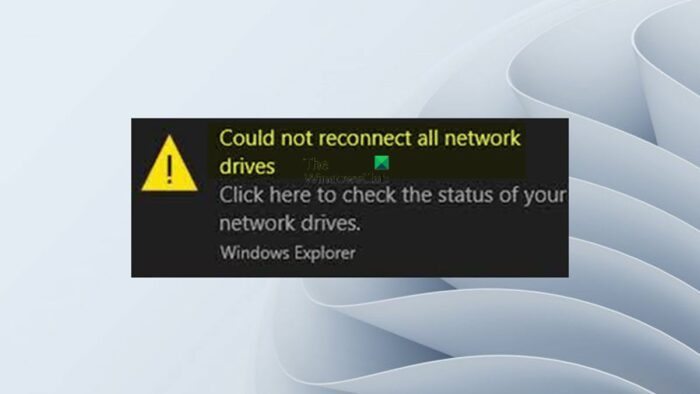
Could not reconnect all network drives
Click here to check the status of your network drives.
You may encounter this issue on your device due to the following two main reasons;
- The mapped drives are not available which could mean that they might be failing or have been disconnected.
- The system tries to map the drives before the network is available because there is a slight delay before the network is available when you sign into Windows.
Fix Could not reconnect all network drives error
If on system startup you get a notification stating Could not reconnect all network drives, then our suggested solutions presented below in no particular order (beginning with the initial checklist) should very well help you resolve this issue on your Windows 11/10 computer.
- Initial checklist
- Configure Group Policy to force Windows to wait for the network
- Create a script to run at startup to map the network drives
- Use Task Scheduler to schedule Mapped Network Drives to run on system startup
Let’s take a look at the description of the process involved concerning each of the listed solutions.
1] Initial checklist
Before you proceed with the solutions proper below for the Could not reconnect all network drives issue on your Windows 11/10 PC, you can run through this initial checklist, and after each task see if your network drives reconnect without issues.
- Make sure Windows is up to date. This could be a bug. So, you can check for updates and install any available bits on your Windows 11/10 device. This will ensure that any bug present in an earlier or previous build/version will most certainly not be present in newer builds/versions, as Windows engineers through feedback are always aware of these bugs and ensure a fix is released in future system updates.
- Disconnect or remove the problematic network drive(s). To do this, press the Windows key + E to open File Explorer, right-click This PC option, and select the Disconnect network drive option from the context menu. In the dialog box that appears, locate the network drive that has an issue (normally, the problematic drive has an X red icon on it), right-click on the drive, and choose the Disconnect option. Reboot your computer and your network will map only the connected devices.
- Unplug and replug the actual external drive. You can simply unplug and then replug or position the external drive correctly. This will allow the computer to map it again.
Read: 5 Troubleshooters to fix Network related problems in Windows
2] Configure Group Policy to force Windows to wait for the network
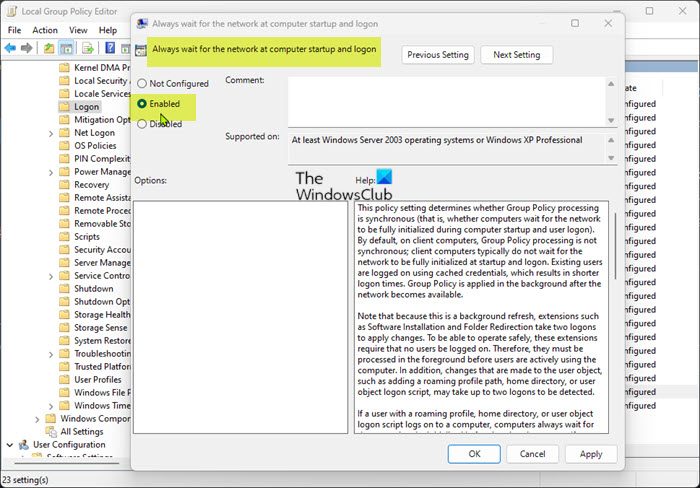
This solution requires you to configure Group Policy to force Windows to wait for the network before it tries to map the drives. To perform this task, do the following:
- Press the Windows key + R to invoke the Run dialog.
- In the Run dialog box type gpedit.msc and press Enter to open Group Policy Editor.
- Inside the Local Group Policy Editor, use the left pane to navigate to the path below:
Computer Configuration > Administrative Templates > System > Logon
- On the right pane, double-click on the Always wait for the network at computer startup and logon policy to edit its properties.
- In the open policy properties window, set the radio button to Enabled.
- Click Apply > OK to save the changes.
- Exit the Local Group Policy Editor.
- Reboot your computer.
If you’re experiencing this issue on Windows 11/10 Home edition, you can follow the instructions in this guide to add the Local Group Policy Editor feature and then carry out the instructions as provided above, or you can apply any other solutions presented below.
TIP: If you wish, you can Turn on or off Could not reconnect all network drives notifications.
3] Create a script to run at startup to map the network drives
This solution requires you to create a script to run at startup to map the network drives. We’ll need to create scripts both for the Command Prompt (.cmd) and PowerShell (.ps1) as the cmd script will call the PowerShell script.
To create the Command Prompt (.cmd) script, follow these steps:
- Press the Windows key + R to invoke the Run dialog.
- In the Run dialog box, type notepad and hit Enter to open Notepad.
- Copy and paste the code below into the text editor.
PowerShell -Command "Set-ExecutionPolicy -Scope CurrentUser Unrestricted" >> "%TEMP%\StartupLog.txt" 2>&1 PowerShell -File "%SystemDrive%\Scripts\MapDrives.ps1" >> "%TEMP%\StartupLog.txt" 2>&1
- Now, click the File option from the menu and select Save As button.
- Choose a location (preferably desktop) where you want to save the file.
- Choose All Files from the Save as type drop-down list.
- Enter a name with .cmd extension (eg; MapDrives.reg).
Next, to create the PowerShell (.ps1) script, follow these steps:
- Open a blank Notepad.
- Copy and paste the code below into the text editor.
while($True){
$error.clear()
$MappedDrives = Get-SmbMapping |where -property Status -Value Unavailable -EQ | select LocalPath,RemotePath
foreach( $MappedDrive in $MappedDrives)
{
try {
New-SmbMapping -LocalPath $MappedDrive.LocalPath -RemotePath $MappedDrive.RemotePath -Persistent $True
} catch {
Write-Host "There was an error mapping $MappedDrive.RemotePath to $MappedDrive.LocalPath"
}
}
$i = $i - 1
if($error.Count -eq 0 -Or $i -eq 0) {break}
Start-Sleep -Seconds 30
}
- Now, click the File option from the menu and select Save As button.
- Choose a location (preferably desktop) where you want to save the file.
- Choose All Files from the Save as type drop-down list.
- Save the file as MapDrives.ps1. You must save the file with this name as the CMD script contains this name for the PowerShell file it will have to call.
Next, after you have created both scripts, you need to set up the StartUp folder to run the script on system startup to keep your network drives connected without triggering the error in highlight.
Do the following:
- Press the Windows key + E to open File Explorer.
- Navigate to the following path:
C:\ProgramData\Microsoft\Windows\Start Menu\Programs\StartUp\
- Alternatively, open the Run dialog box, then copy and paste the environment variable below and hit Enter.
%ProgramData%\Microsoft\Windows\Start Menu\Programs\StartUp
- At the location, copy the CMD script that you created to this folder.
- Next, go to your system drive and create a folder, and name it Scripts.
- Once you have created the folder, paste the PowerShell script into the folder.
- Finally, reboot your system.
Read: How to run .sh or Shell Script file in Windows 11
4] Use Task Scheduler to schedule Mapped Network Drives to run on system startup
This solution is an alternative to using the StartUp folder as described above. You can use Task Scheduler to schedule a task that will run on startup which will execute the scripts that we have created already. To schedule, the PowerShell script, follow these steps:
- Press the Windows key + R to invoke the Run dialog.
- In the Run dialog box, type taskschd.msc and hit Enter to Open Task Scheduler.
- In Task Scheduler, click on the Action drop-down menu.
- Click the Create Task option to start the automated task creation process.
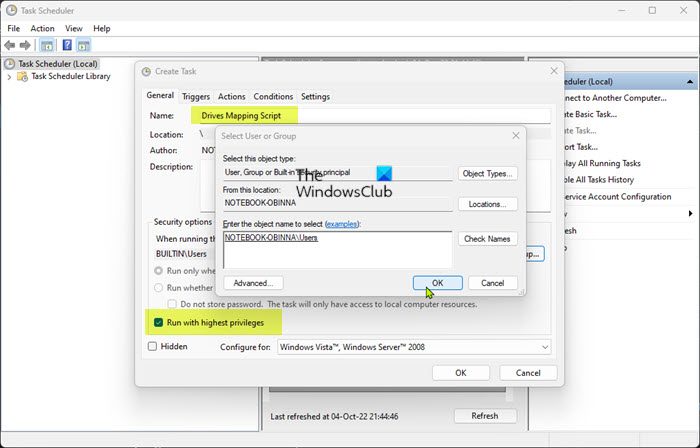
- In the General tab, assign the task a descriptive name (for example Drives Mapping Script).
- Next, click on the Change User or Group button.
- In the Select User or Group dialog that pops up, in the Enter the object name to select field, type users, and click the Check Names button to select a local user or group.
- Click the OK button.
- Next, checkmark the Run with highest privileges option
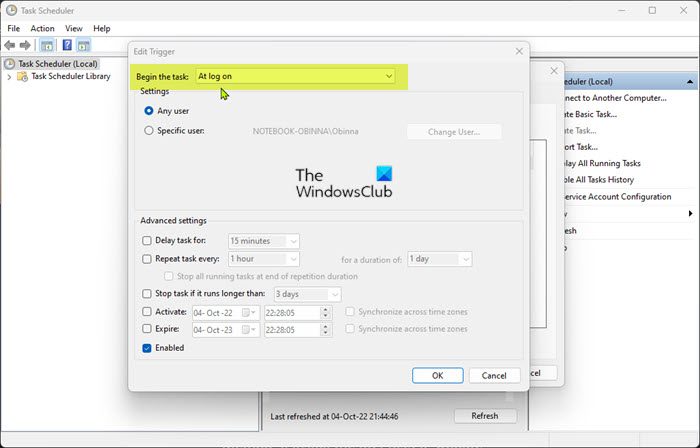
- Now, click on the Triggers tab.
- Click the New button.
- For the Begin the task option, choose the At log on option from the drop-down menu.
- Click on the OK button.
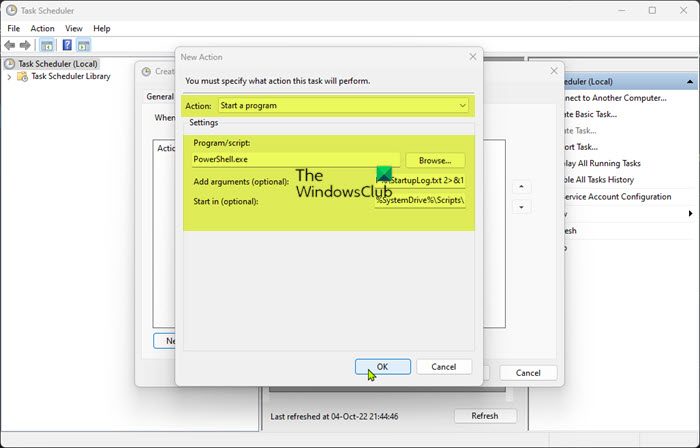
- Now, switch to the Actions tab.
- Click the New button again.
- Select Start a program from the Action drop-down menu.
- In the Program/script field, type PowerShell.exe.
- Next, in the Add arguments (optional) field, copy and paste the command below:
-windowsstyle hidden -command .\MapDrives.ps1 >> %TEMP%\StartupLog.txt 2>&1
- In the Start in (optional) field, type the following location of the PowerShell script created earlier:
%SystemDrive%\Scripts\
- Click the OK button.
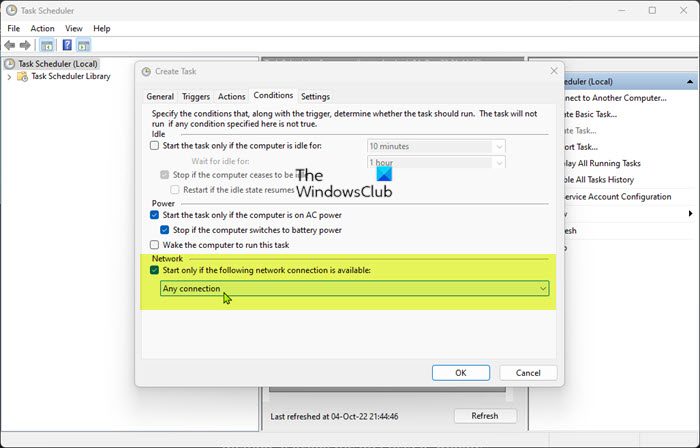
- Now, switch to the Conditions tab.
- Under the Network section, make sure the Start only if the following network connection is available option is checked.
- From the drop-down menu, select the Any connection option.
- Click the OK button.
- Exit Task Scheduler.
- Restart computer.
Read: How to run Scheduled Task after another Task completes
These posts might interest you:
- Mapped Network Drive, not opening, connecting, syncing, or working
- Mapped Network Drive not showing in Windows
- Explorer crashes or freezes while accessing Mapped Network Drives
Why are my network drives disconnected?
Two things could be responsible for this error on Windows 11/10 computer. First, if the mapped drivers are truly disconnected due to some error, you can find this problem. Secondly, it appears when your PC or system tries to map the drive even before it is available. In other words, your system needs to wait for a few seconds before it starts mapping the network drive.
Could not reconnect all network drives what does that mean?
If you encounter the Could not reconnect all network drives issue on your Windows 11/10 PC, it simply indicates that the network drives that you mapped before can’t be connected to your machine. If you go to Windows Explorer, you will see a red X icon on the mapped network hard drive icon.
Read: How to clear Mapped Network Drive Cache in Windows 11/10
Leave a Reply